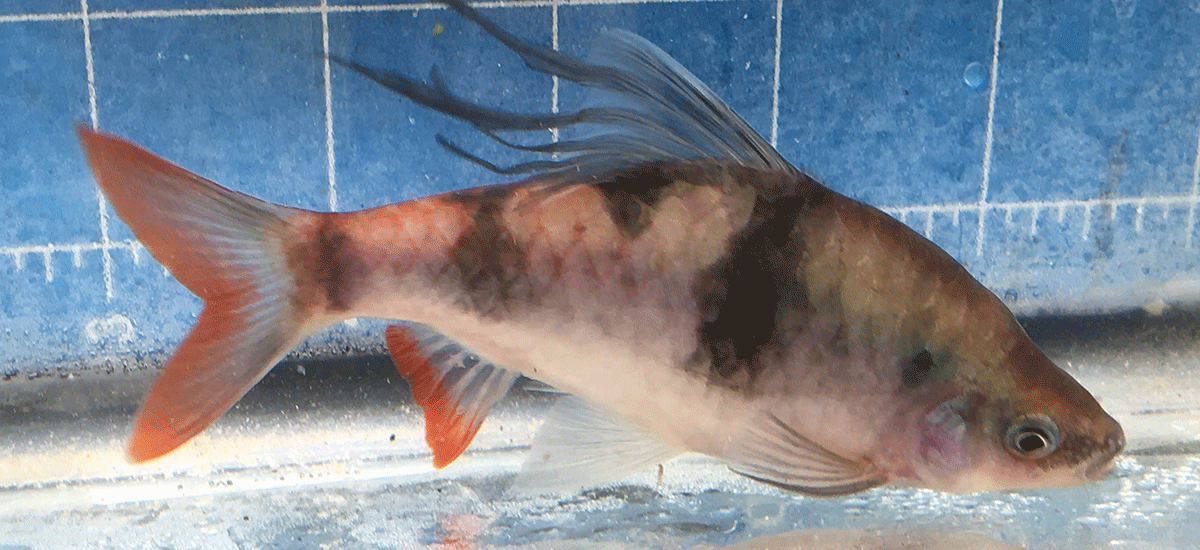A male Arulius Barb (Puntius arulius or maybe Dawkinsia tambraparniei) in front of a one-inch grid to show size. Note the filaments on his dorsal.
Recently I got this email from a customer (slightly edited):
“Hi Charles. I hope you guys fared the cold weather well. I just wanted to give you some feedback on the barbs that were sold as arulius barbs. They’re gorgeous and healthy. I believe they’re actually Dawkinsia tambraparniei. The difference between the two (explained later in this blog) is apparently the filaments on the dorsal fin. This fish is listed on IUCN as an endangered species. I don’t know if you knew that or if that’s why you breed them, but I thought I’d take a minute to thank you for doing so.”
Okay. We sell this fish as Puntius arulius. The genus Puntius is under revision by several researchers. Some of the species in Puntius have been moved by some taxonomists to the genus Dawkinsia. And, species that were once considered one have been split into multiple species. The “Arulius Barbs” we raise have males with filaments on their dorsal fins. And some authorities place that fish in the species tambraparniei and move it into the genus Dawkinsia, hence our customer calling this fish Dawkinsia tambraparniei. After reviewing the literature long before this email, I tended to agree with these changes in nomenclature. So, why do we still use the name Puntius arulius?
The answer is simple and pragmatic: revisions occur continuously in the taxonomic literature. As these revisions are made, some authorities accept the changes and others don’t. Some changes never achieve consensus. I’ve seen a genus split to just have it reconstituted a few years later. So, what is one to do? Our solution? We’ve picked one authority to use. That authority is www.itis.gov, the Integrated Taxonomic Information System.
Here’s how ITIS describes itself:
“Welcome to ITIS, the Integrated Taxonomic Information System! Here you will find authoritative taxonomic information on plants, animals, fungi, and microbes of North America and the world. We are a partnership of U.S., Canadian, and Mexican agencies (ITIS-North America); other organizations; and taxonomic specialists. ITIS is also a partner of Species 2000 and the Global Biodiversity Information Facility (GBIF). The ITIS and Species 2000 Catalogue of Life (CoL)partnership is proud to provide the taxonomic backbone to the Encyclopedia of Life (EOL).”
Here’s more from their website:
“An overriding goal of the ITIS project is to provide accurate, scientifically credible, and current taxonomic data that meet the needs of the ITIS partners and the user public. To accomplish this goal we have established a set of standards and guidelines. The initial version of ITIS includes National Oceanographic Data Center (NODC) data, with modifications. As groups are reviewed, quality indicators for credibility, completeness, and currency will be associated with each record. See the Data Development History and Quality Indicators page for more information. Potential contributors to ITIS are encouraged to view the ITIS Submittal Guidelines. ITIS welcomes suggestions and questions, and welcomes email feedback at itiswebmaster@itis.gov.
“ITIS does not intend to serve as a forum for cutting-edge taxonomic classifications. Rather, ITIS is meant to serve as a standard to enable the comparison of biodiversity datasets, and therefore aims to incorporate classifications that have gained broad acceptance in the taxonomic literature and by professionals who work with the taxa concerned.”
Note the statement, “ITIS does not intend to serve as a forum for cutting-edge taxonomic classifications.” ITIS, is by planning, a conservative organization. It doesn’t respond to whims; it waits for general consensus.
There are other authorities we could use but having decided to pick one (to make my life easier), we opted to use ITIS.
So, if you go to www.itis.gov (As write I write this anyway. This could change at any time, in which case we’ll change.), check “scientific name,” and enter “dawkensia,” you get no hits. The name doesn’t exist in the database. Furthermore, if you enter “tambraparniei,” you also get no hits. If, however, you enter “puntius arulius” you get its taxonomic information; it exists.
For the time being, we’ll stick with our authority, www.itis.gov and call this fish Puntius arulius.
By the way, here’s what IUCN (actually “The IUCN List of Threatened Species™” at http://www.iucnredlist.org/search) says under its taxonomic notes:
“This species was transferred to Dawkinsia following Pethiyagoda et al. (2012). Dawkinsia tambraparniei was described as Puntius arulius tambraparniei from Tambraparini River, Tamil Nadu by Silas (1954). The species status was validated by Pethiyagoda and Kottelat (2005) in their revision of the Puntius filamentosus complex.”
As to its threatened status, IUCN says:
“Dawkinsia tambraparniei is assessed as Endangered as it has a restricted distribution of less then [sic] 5,000 km² extent and less than 100 km² area occurring in only 3–5 fragmented locations. There are ongoing threats the species including habitat decline due to removal of riparian cover, sand mining and industrial and organic pollution and exploitation for the aquarium trade.”
And:
“Dawkinsia tambraparniei is endemic to the Western Ghats of India. All the current records of this species (Silas 1954, Pethiyagoda and Kottelat 2005, Johnson and Arunachalam 2009, Devi et al. 2010) are from the upper and middle reaches of Tambraparniei river basin in Tirunelveli District, southern Tamil Nadu. The range of this species, based on the hydrobasin area, is between 4,000 and 4,500 km², however the area is highly restricted to just 1–2% of the range, of less than 100 km².”
If indeed the Arulius Barb is threatened, we are proud to maintain a healthy breeding population of the species. For a little more information about this species in our systems, see my blog: https://goliadfarms.com/puntius-arulius/.
Good fishkeeping!


Sandy says
Do you have any of these aurulius barbs now?
Charles Clapsaddle says
Sandy,
I’m sorry for the tardy response. I just saw this message.
We lost all our Puntius arulius barbs in the Texas Winter Storm and its aftermath.
Charles